THE LIFE OF A ZOOKEEPER
 People have many different perceptions of what working as a Zookeeper actually involves, however by far the most overwhelming misconception I encounter is something along the lines of…
People have many different perceptions of what working as a Zookeeper actually involves, however by far the most overwhelming misconception I encounter is something along the lines of…
“Wow you get paid to play with and cuddle animals all day, you have the best job in the world!”
Now while the first half of that statement couldn’t be further from the truth, it certainly doesn’t prevent the latter from being true! Zookeeping is a hugely rewarding career and any zookeeper you ask will more than likely tell you it is indeed the best job in the world, but it is also much more hard work and much less cuddling than you might think!
We start our day bright and early at 9am, with plenty of tasks to complete before we open to the public. The very first thing we do every day is walk around the whole zoo, checking in on every animal. We perform a head count; give a quick visual health check; and I personally have a little chat with them too!
After our checks we start on some pre-opening cleaning. Overnight, many of our trees shed their leaves onto the paths and our free roaming birds quite often poop on them too! No one wants any nasty surprises on the bottom of their shoes, so we make sure all public pathways are swept before we open!
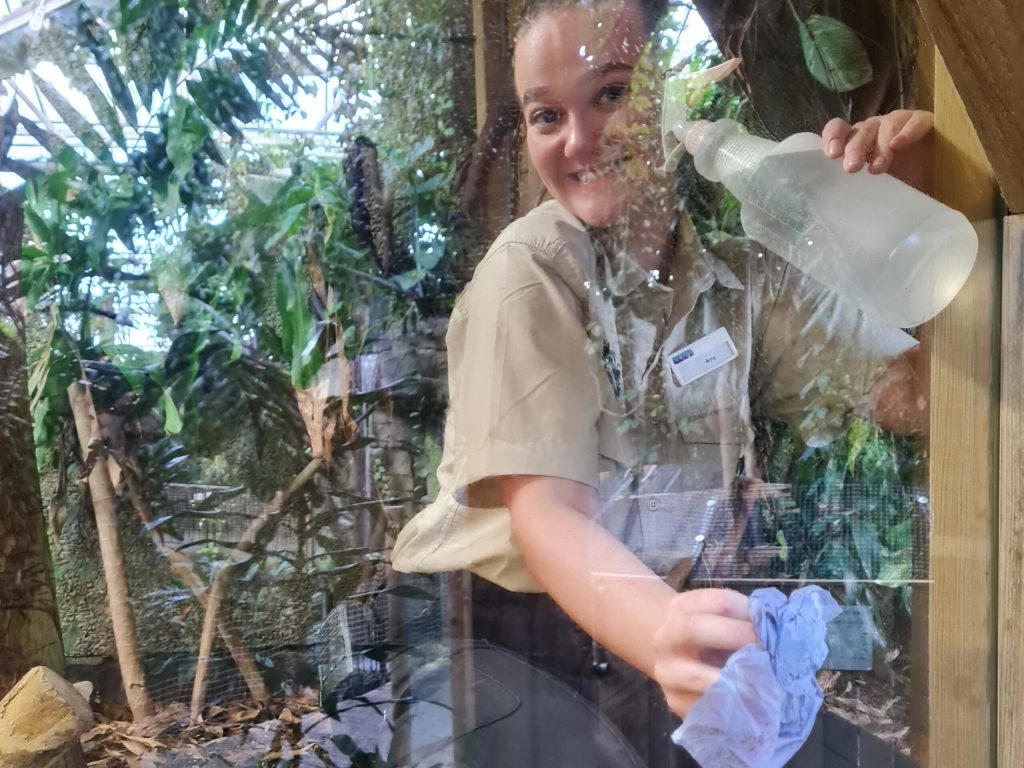
The final job we do before we open is clean and buff all our glass. We want our visitors to have a perfect view of our animals and the same goes for our animals too!
Once open at 10am, we get started on the animal’s favourite part of the day, feeding. The variety and frequency of our animals’ feed varies drastically. Our meerkats have three meals a day and Clyde, our Burmese python only eats once a month so there is a lot of planning and organising that goes into feeding. Luckily, we have a detailed feeding guide which tells us what, when and how to feed all our animals.
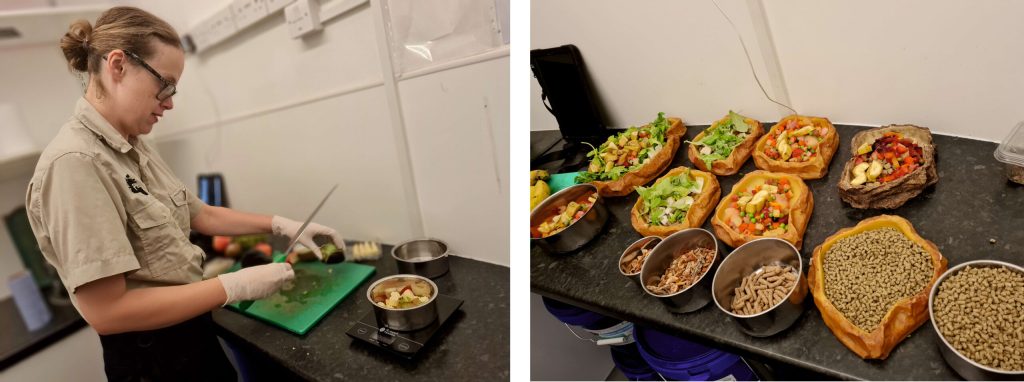
Our animals eat a variety of foods from fruits and vegetables to insects and mice. We receive regular orders of all our food for our animals to ensure it is all fresh and new. Once everything is prepped, we make our way around giving everyone their breakfast. Some animals, such as Oscar, our green iguana, take a more leisurely approach to feeding time while others such as our marmosets help themselves to the food before we even make it to the feeding stations! It really is feeding time at the zoo!
As we are doing our rounds feeding, we also take time to change and refresh water bowls and do a quick poop scoop as there is always plenty of poop to scoop!
After all our animals are well fed and happy, the least glamorous part of the job begins, the cleaning. Just like the feeding, the cleaning jobs vary wildly from frequency to time taken to depth of cleaning. Luckily, just like our feeding, we also have a cleaning guide which lets us know what needs cleaning on what day.
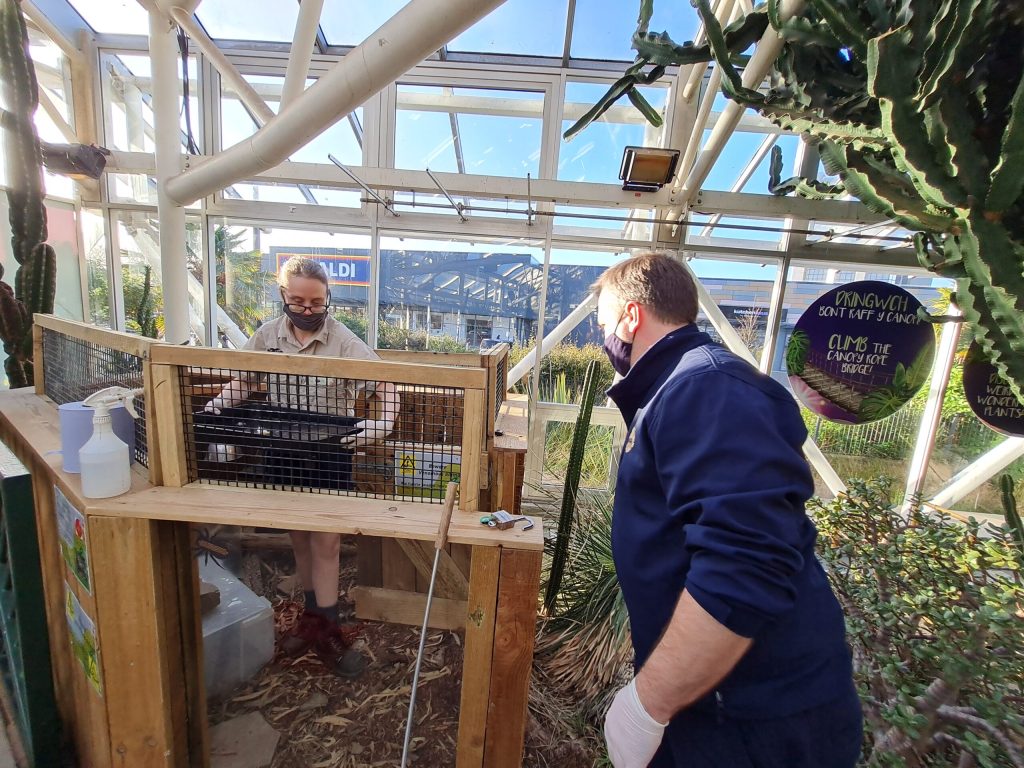
No two days are the same when it comes to cleaning. We could be performing water tests and water changes on our fish tanks, disinfecting and scrubbing down the perches in Rainbow the macaw’s enclosure or even performing a full enclosure substrate change on our giant african land snails or cockroaches. Most animals are very well behaved and stay out of the way when cleaning, some like to “help” with the cleaning process, Haku our Asian water monitor is the best example of this!
Occasionally, it is all hands-on deck for a major clean. Twice a year, our meerkats, Peanut and Butter have all the sand in their enclosure taken out and replaced. This takes many hours, and we certainly burn off our calories that day!
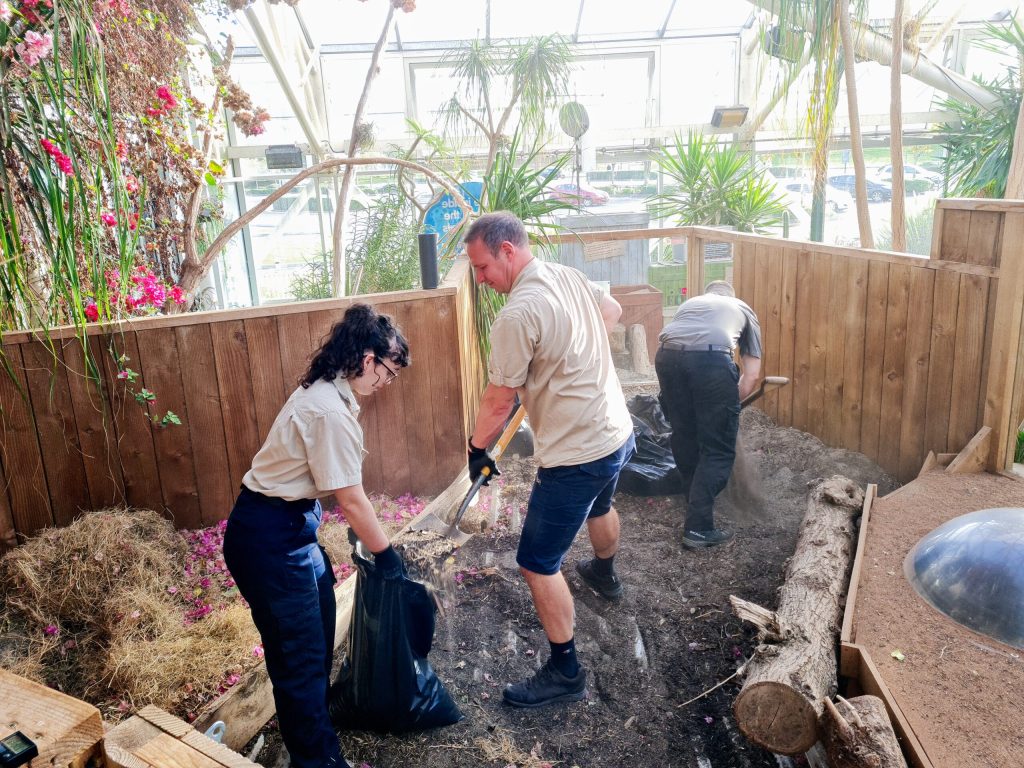
Another very important thing we do every day is monitoring the temperatures of our enclosures. Many of our animals are cold blooded, which means they are unable to generate their own body heat. This means the correct temperature is essential to their survival. The preferred temperatures vary greatly for every animal, the golden poison dart frog prefers a pleasant 18-24c while Haku, our asian water monitor, likes it as hot as 50c! Absolutely sweltering!  Every one of our land animals have a thermometer in their enclosure that records their highest and lowest temperature. We then have a chart of each animal’s preferred temperature to compare against. This helps us ensure that all our animals are at the perfect temperature at all times. We are regularly heating up and cooling down enclosures as the outside temperature changes to make sure all our animals are comfortable and happy.
Every one of our land animals have a thermometer in their enclosure that records their highest and lowest temperature. We then have a chart of each animal’s preferred temperature to compare against. This helps us ensure that all our animals are at the perfect temperature at all times. We are regularly heating up and cooling down enclosures as the outside temperature changes to make sure all our animals are comfortable and happy.
Over the month, many of our animals are weighed to keep track and record their weights over time. For our growing animals such as our Fiji banded iguana, we are hoping that he gains a little weight each month as he gets bigger. For our adult animals such as our Sinaloan milk snake, a constant weight is perfect for him. A couple of animals, not naming names here, could do with losing a couple of pounds!
The weighing of some animals is a good way to keep track of egg production as well. Our Egyptian tortoises for example, steadily climb in weight while they are producing an egg and suddenly drop a large amount when they have laid it. The hard task then is finding the buried egg! We also use this time to perform extensive health checks where the animals are checked all over for any signs of injury or ill health.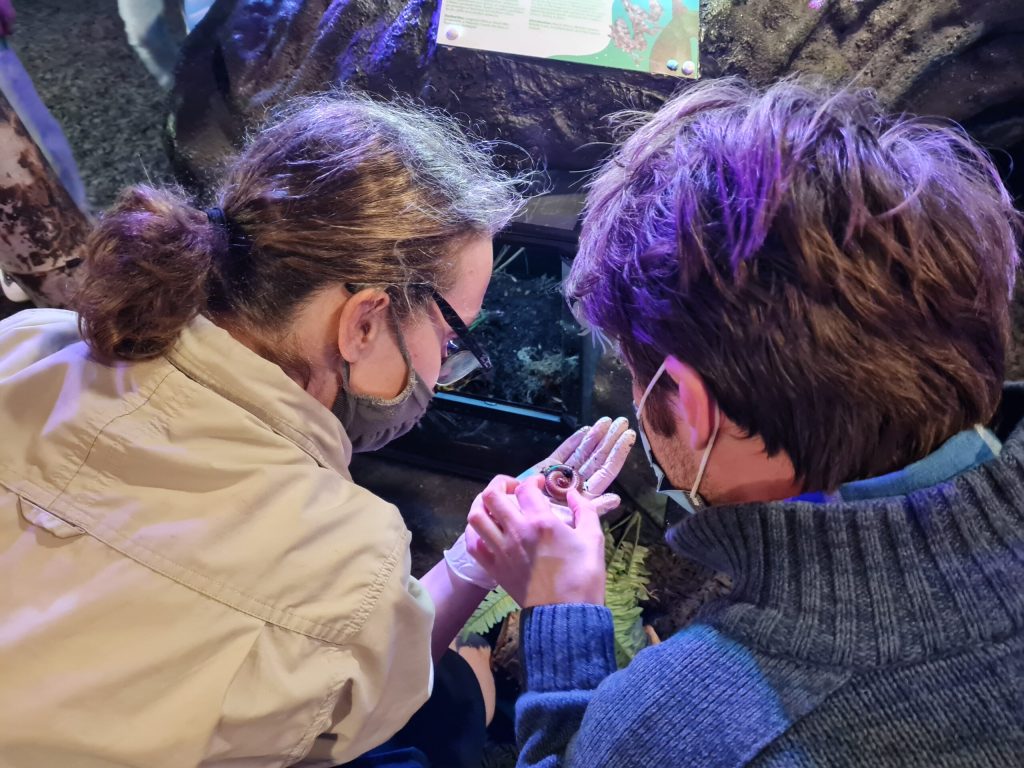 One of our less glamorous jobs is testing the animals for various intestinal illnesses. This means collecting their poop! Once a week, we collect poo samples from a collection of animals and send them off to our zoo vet to be tested for various diseases. This means we can keep on top of any illnesses that may harm either our animals or us humans.
One of our less glamorous jobs is testing the animals for various intestinal illnesses. This means collecting their poop! Once a week, we collect poo samples from a collection of animals and send them off to our zoo vet to be tested for various diseases. This means we can keep on top of any illnesses that may harm either our animals or us humans.
Probably one of the more rewarding parts of the day is working on enclosure design. We are currently working on making a large portion of our enclosures bioactive. This means filling our enclosures with natural plants and adding small bugs to the substrate, thus making the whole enclosure a living, breathing exhibit. This will greatly enrich the animals lives, and save us some time too!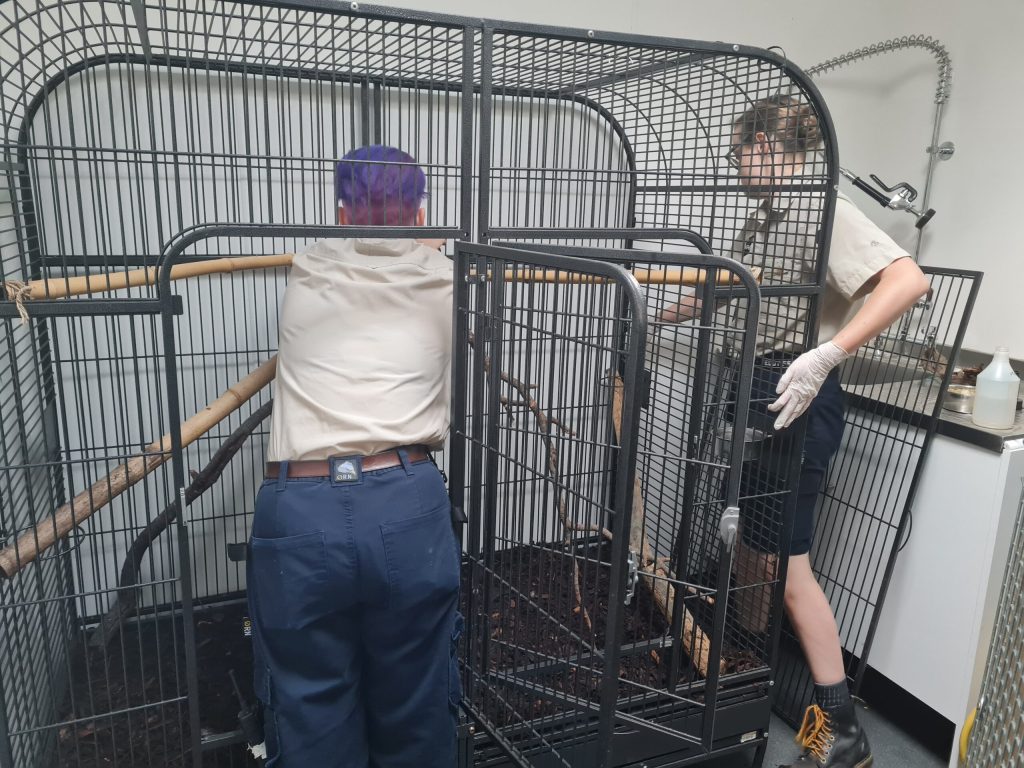 Plans are always in place for redesigns of our larger enclosures. Whether it is creating new lookout platforms for our leopard cats, Nala and Aneurin or replacing the branches Rainbow our green wing macaw has torn down, there is always a big project on the horizon for us to complete.
Plans are always in place for redesigns of our larger enclosures. Whether it is creating new lookout platforms for our leopard cats, Nala and Aneurin or replacing the branches Rainbow our green wing macaw has torn down, there is always a big project on the horizon for us to complete.
A large part of our role is dedicated to providing a variety of educational workshops for schools and experiences for our visitors. Most weekdays we have schools visiting to take part in workshops such as minibeasts and rainforest rangers, where the children get to learn about all our animals in a hands-on environment.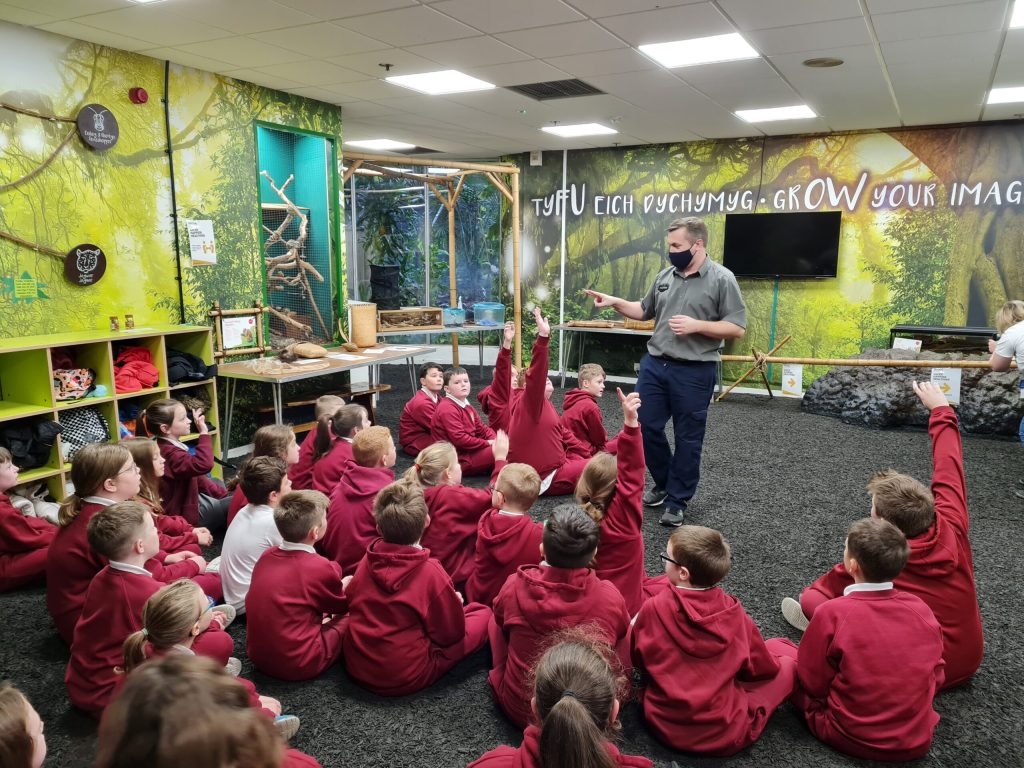 The educational experiences don’t end during the weekend either as we take part in our zookeeper experiences, caiman feeds and birthday parties, enabling our visitors to get up close and personal with our animals and hopefully encourage the next generation of zookeepers just like ourselves!
The educational experiences don’t end during the weekend either as we take part in our zookeeper experiences, caiman feeds and birthday parties, enabling our visitors to get up close and personal with our animals and hopefully encourage the next generation of zookeepers just like ourselves!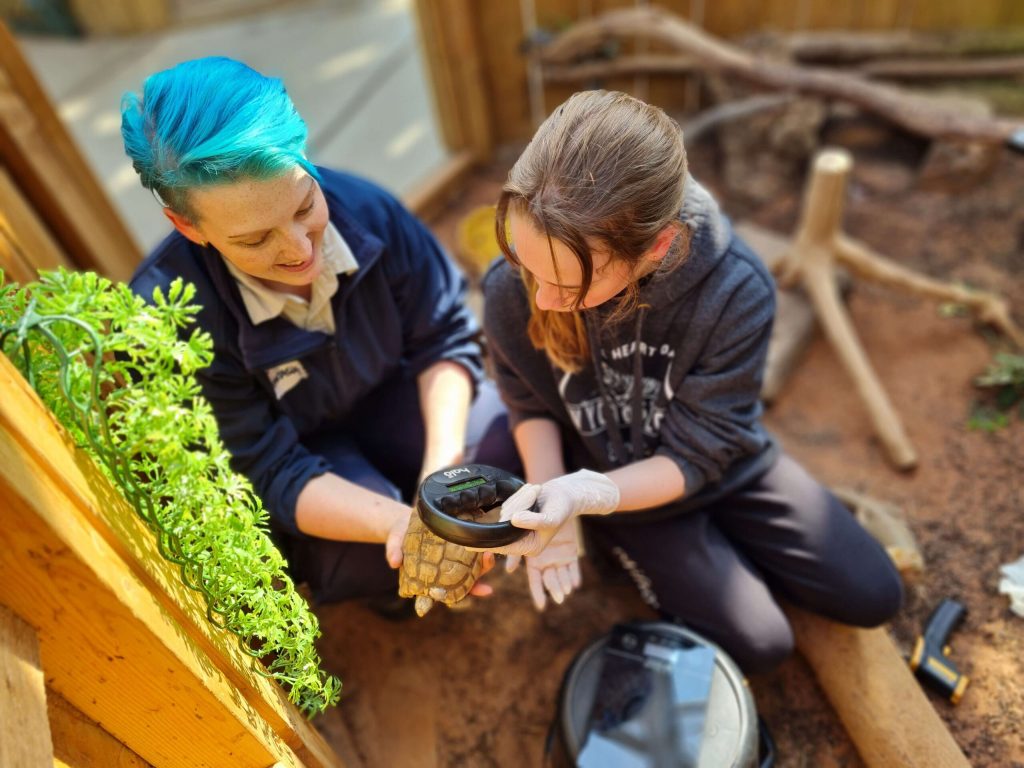 It is finally the last hour of our day, and the animals are getting themselves ready for bed. During this time, we walk around the zoo one last time to check once again that all our animals are happy and healthy. As we are heading around, we collect food bowls and any uneaten food, empty bins and tidy up the pathways. We then perform a deep clean of our food preparation area, making sure everything is sparking clean for tomorrow’s zookeeper!
It is finally the last hour of our day, and the animals are getting themselves ready for bed. During this time, we walk around the zoo one last time to check once again that all our animals are happy and healthy. As we are heading around, we collect food bowls and any uneaten food, empty bins and tidy up the pathways. We then perform a deep clean of our food preparation area, making sure everything is sparking clean for tomorrow’s zookeeper!
So, there it is, a typical day in the life of a Zookeeper! What we do varies greatly day to day, and no two days are ever the same. We could be visiting the vets with a sick animal, travelling to zoos all across the country collecting new arrivals or even waiting eagerly for a new baby to be born! It may not quite be the cuddle-fest that a lot of people expect, but we are extremely passionate about what we do, and we wouldn’t have it any other way!
by Zookeeper Catherine Royle
